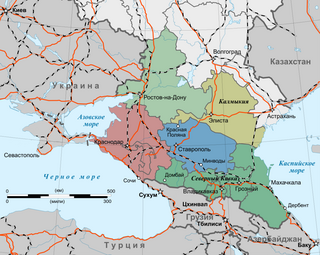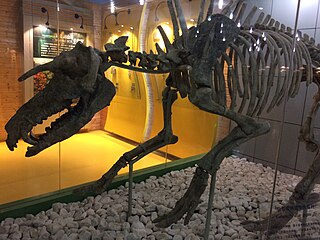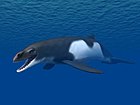
The Caucasus Mountains is a mountain range at the intersection of Asia and Europe. Stretching between the Black Sea and the Caspian Sea, they are surrounded by the Caucasus region and are home to Mount Elbrus, the highest peak in Europe at 5,642 metres (18,510 ft) above sea level.

The Republic of Adygea, also known as the Adygean Republic, is a republic of Russia. It is situated in the North Caucasus of Eastern Europe. The republic is a part of the Southern Federal District, and covers an area of 7,600 square kilometers (2,900 sq mi), with a population of roughly 496,934 residents. It is an enclave within Krasnodar Krai and is the fifth-smallest Russian federal subject by area. Maykop is the capital and the largest city of Adygea, home to one-third of the republic's population.

The North Caucasus, or Ciscaucasia, is a region in Europe governed by Russia. It constitutes the northern part of the wider Caucasus region, which forms the natural border between Eastern Europe and Western Asia. It is bordered by the Sea of Azov and Black Sea to the west, the Caspian Sea to the east, and the Caucasus Mountains to the south. The region shares land borders with the South Caucasus countries of Georgia and Azerbaijan. Located in the south of the region, Mount Elbrus is the tallest peak in Europe. Among its urban centres, Krasnodar is the most populous.

Maykop is the capital city of Adygea, Russia, located on the right bank of the Belaya River. It borders Maykopsky District, from which it is administratively and municipally independent, to the east and south; Giaginsky District to the north, and Belorechensky District of Krasnodar Krai to the west.

The Molidae comprise the family of the molas or ocean sunfishes, unusual fish whose bodies come to an end just behind the dorsal and anal fins, giving them a "half-fish" appearance. They are also the largest of the ray-finned bony fish, with the southern sunfish, Mola alexandrini, recorded at 4.6 m (15 ft) in length and 2,744 kg (6,049 lb) in weight.

North Caucasus Economic Region is one of 12 economic regions of Russia. It comprises the whole of the North Caucasian Federal District and the western federal subjects of the Southern Federal District.

The Western Caucasus is a western region of the North Caucasus in Southern Russia, extending from the Black Sea to Mount Elbrus.

The peoples of the Caucasus, or Caucasians, are a diverse group comprising more than 50 ethnic groups throughout the Caucasus.

Cetotherium is an extinct genus of baleen whales from the family Cetotheriidae.

Orography of Azerbaijan refers to the rocky, mountainous and elevated terrains in Azerbaijan. The tectonic structure is typical for the orography of the country. The main morphostructural units are the Greater Caucasus, the Lesser Caucasus, the Gusar plane, the Samur-Devechi lowland, the Kur intermountain trough, the Karabagh volcanic highland, the near and middle Araz Ridges and Talysh Mountains.

The Circassian flag is the national flag of the Circassians. It consists of a green field charged with twelve gold stars, nine forming an arc resembling a bow and three horizontal, also charged with three crossed arrows in the center. Seferbiy Zaneqo, a Circassian diplomat, is the designer of the flag. Every year, April 25 is celebrated as the Circassian flag day by Circassians. Another version of the flag is currently officially used by the Republic of Adygea of the Russian Federation as its national flag.

Kubanochoerus is an extinct genus of large, long-legged suid artiodactyl mammal from the Miocene of Eurasia and Africa.

Circassian nationalism is the desire among Circassians worldwide to preserve their genes, heritage and culture, save their language from extinction, raise awareness about the Circassian genocide, return to Circassia and establish a completely autonomous or independent Circassian state in its pre-Russian invasion borders.

Cetotheriidae is a family of baleen whales. The family is known to have existed from the Late Oligocene to the Early Pleistocene before going extinct. Although some phylogenetic studies conducted by Fordyce & Marx 2013 recovered the living pygmy right whale as a member of Cetotheriidae, making the pygmy right whale the only living cetotheriid, other authors either dispute this placement or recover Neobalaenidae as a sister group to Cetotheriidae.

Mithridatocetus is a genus of cetotheriid mysticete in the subfamily Cetotheriinae. Known specimens have been found in marine deposits in Crimea, Ukraine, and the Russian Caucasus.
Kurdalagonus is a genus of cetotheriid mysticete in the subfamily Cetotheriinae from the Miocene of the Russian Caucasus.
Vampalus is a genus of cetotheriid mysticete from Miocene (Tortonian) marine deposits in the Russian Caucasus. The type species, V. sayasanicus, is based on PIN 5341/1, a complete skeleton. The cetotheriid Eucetotherium helmersonii was mistakenly assigned to Vampalus by Tarasenko and Lopatin, who were unaware that Kellogg (1931) fixed "Cetotherium" helmersonii as the Eucetotherium type species.
Otradnocetus is an extinct genus of baleen whale from the middle Miocene of the Russian Caucasus.

Sultan Khan-Giray was a Circassian politician and representative of the Circassian aristocracy, ethnographer, folklorist, art critic, author. He is considered one of the founders of Circassian ethnography and historical science.


















